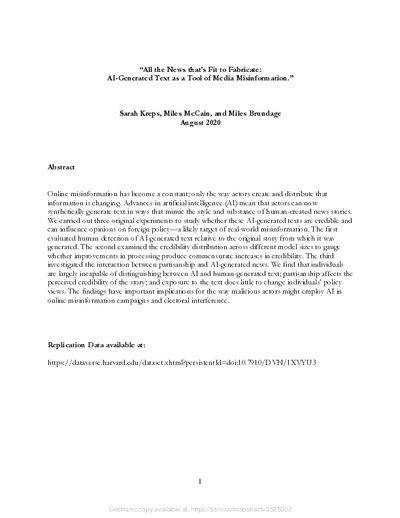All the News that’s Fit to FabricateAI-Generated Text as a Tool of Media Misinformation
Sarah Kreps, Miles McCain, Miles Brundage
Publikationsdatum:
|
 |
 Diese Seite wurde seit mehr als 7 Monaten inhaltlich nicht mehr aktualisiert.
Unter Umständen ist sie nicht mehr aktuell.
Diese Seite wurde seit mehr als 7 Monaten inhaltlich nicht mehr aktualisiert.
Unter Umständen ist sie nicht mehr aktuell.
 Zusammenfassungen
Zusammenfassungen
Online misinformation has become a constant; only the way actors create and distribute that
information is changing. Advances in artificial intelligence (AI) mean that actors can now
synthetically generate text in ways that mimic the style and substance of human-created news stories.
We carried out three original experiments to study whether these AI-generated texts are credible and
can influence opinions on foreign policy—a likely target of real-world misinformation. The first
evaluated human detection of AI-generated text relative to the original story from which it was
generated. The second examined the credibility distribution across different model sizes to gauge
whether improvements in processing produce commensurate increases in credibility. The third
investigated the interaction between partisanship and AI-generated news. We find that individuals
are largely incapable of distinguishing between AI and human-generated text; partisanship affects the
perceived credibility of the story; and exposure to the text does little to change individuals’ policy
views. The findings have important implications for the way malicious actors might employ AI in
online misinformation campaigns and electoral interference.
Von Sarah Kreps, Miles McCain, Miles Brundage im Text All the News that’s Fit to Fabricate (2020)  Dieser wissenschaftliche Zeitschriftenartikel erwähnt ...
Dieser wissenschaftliche Zeitschriftenartikel erwähnt ...
 Dieser wissenschaftliche Zeitschriftenartikel erwähnt vermutlich nicht ...
Dieser wissenschaftliche Zeitschriftenartikel erwähnt vermutlich nicht ... 
 Nicht erwähnte Begriffe | Chat-GPT, Generative Pretrained Transformer 3 (GPT-3), GMLS & Bildung |
 Tagcloud
Tagcloud
 Zitationsgraph
Zitationsgraph
 Zitationsgraph (Beta-Test mit vis.js)
Zitationsgraph (Beta-Test mit vis.js)
 2 Erwähnungen
2 Erwähnungen 
- How to spot AI-generated text (Melissa Heikkilä) (2022)


- The impact of generative artificial intelligence on socioeconomic inequalities and policymaking (Valerio Capraro, Austin Lentsch, Daron Acemoglu, Selin Akgun, Aisel Akhmedova, Ennio Bilancini, Jean-François Bonnefon, Pablo Brañas-Garza, Luigi Butera, Karen Douglas, Jim Everett, Gerd Gigerenzer, Christine Greenhow, Daniel Hashimoto, Julianne Holt-Lunstad, Jolanda Jetten, Simon Johnson, Werner Kunz, Chiara Longoni, Pete Lunn, Simone Natale, Stefanie Paluch, Iyad Rahwan, Neil Selwyn, Vivek Singh, Siddharth Suri, Jennifer Sutcliffe, Joe Tomlinson, Sander van der Linden, Paul Van Lange, Friederike Wall, Jay Van Bavel, Riccardo Viale) (2024)


 Anderswo finden
Anderswo finden
 Volltext dieses Dokuments
Volltext dieses Dokuments
 |  All the News that’s Fit to Fabricate: Artikel als Volltext ( All the News that’s Fit to Fabricate: Artikel als Volltext ( : :  , 395 kByte; , 395 kByte;  : :  ) ) |
 Anderswo suchen
Anderswo suchen 
 Beat und dieser wissenschaftliche Zeitschriftenartikel
Beat und dieser wissenschaftliche Zeitschriftenartikel
Beat hat Dieser wissenschaftliche Zeitschriftenartikel während seiner Zeit am Institut für Medien und Schule (IMS) ins Biblionetz aufgenommen. Beat besitzt kein physisches, aber ein digitales Exemplar. Eine digitale Version ist auf dem Internet verfügbar (s.o.). Aufgrund der wenigen Einträge im Biblionetz scheint er es nicht wirklich gelesen zu haben. Es gibt bisher auch nur wenige Objekte im Biblionetz, die dieses Werk zitieren.









 Fake-News
Fake-News Generative Machine-Learning-Systeme (GMLS)
Generative Machine-Learning-Systeme (GMLS) GPT-2
GPT-2 Künstliche Intelligenz (KI / AI)
Künstliche Intelligenz (KI / AI)
 Biblionetz-History
Biblionetz-History